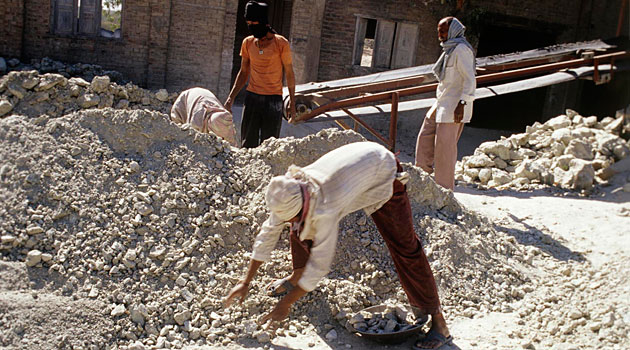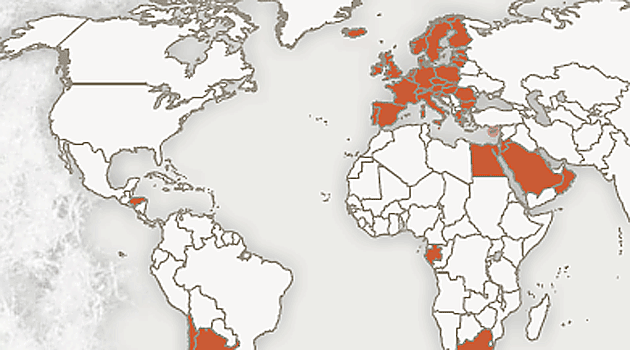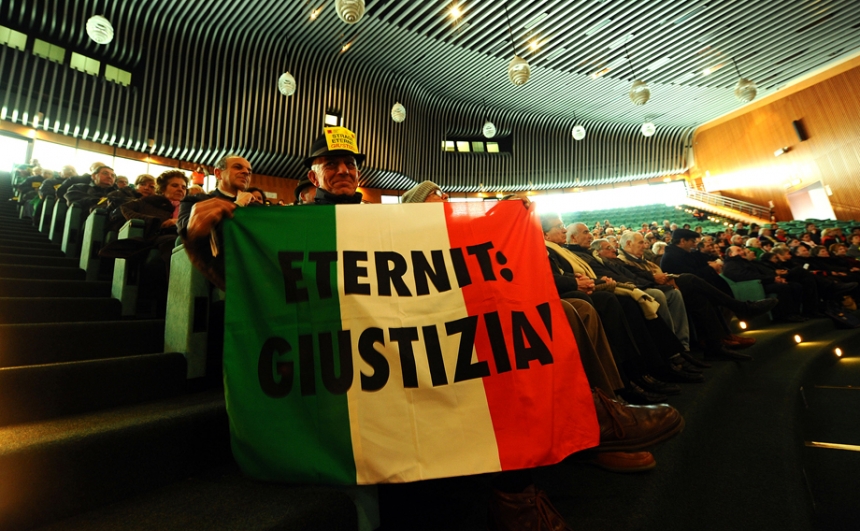NEW DELHI — Every day, the swirling waters of the Arabian Sea bring misery to Alang, the world’s largest ship-breaking yard in western India’s Gujarat state. An estimated 55,000 workers, unmindful of the lethal effects of asbestos-laden material in the vessels, slave for long hours and, in the process, are exposed to deadly fibers. The Indian government is aware of the risks but loath to interfere: The men need jobs, and the Indian economy, among the world’s fastest-growing, needs secondary steel from the beached vessels. “Reclamation and recycling,” says Pravin Nagarsheth, president of the Iron Steel Scrap and Ship Breakers Association of India (ISSAI), “is a highly lucrative business.”
One hundred-twenty miles (two hundred kilometers) north of Alang, workers at hundreds of dusty asbestos factories in the city of Ahmedabad face similar hazards in the name of economic development: lung cancer, asbestosis, and a rapacious malignancy, usually found in the chest cavity, called mesothelioma. In this case the end product is asbestos sheet, widely used in construction.
The two locales are centers of an emerging epidemic of asbestos-related disease in India.
Valued for its heat and fire resistance, asbestos was once widely used worldwide, but it is now banned or restricted by 52 countries. Use of the mineral is banned entirely in the European Union. In the United States — where it is blamed for some 200,000 deaths and cost the industry $70 billion in damages and litigation costs — asbestos use is limited to a handful of products, such as automobile brakes and gaskets.
But in India, asbestos use is booming.
The country is now the world’s second largest asbestos market, behind only China, consuming nearly 350,000 metric tons in 2008. The industry generates more than $850 million a year in revenue, and directly employs 300,000 people; indirectly, it supports as many as 3 million more. Backed by a powerful lobby, asbestos use in India has risen by 83 percent since 2004, according to government figures. Given evidence of poor workplace safety and weak regulations, such widespread use could prove disastrous, say health experts. One study by two New Delhi researchers suggests that by 2020 deaths from asbestos-related cancers could reach 1 million in developing nations. “The industry is using its economic and political power in a way that’s allowing it totally unrestrained growth,” says Barry Castleman, a U.S. environmental consultant who advises the World Health Organization on asbestos. “We can only expect untold numbers of preventable deaths to occur as a result.”
According to recent estimates by the Asbestos Cement Products Manufacturers’ Association (ACPMA), a New Delhi-based industry organization, the Indian asbestos market grew by more than 30 percent just in the past year, primarily because of demands in the country’s rural sector. “The asbestos market — despite being a health hazard — has grown because it serves the market for poor,” says Gopal Krishna of the Ban Asbestos Network of India (BANI). “And that market is growing at a tremendous pace. So, nobody has the time for complaints.”
A Potent Lobby
In India, asbestos products carry no health warning labels and trade unions have no mandate to prevent asbestos-related disease at workplaces. Although researchers around the world have linked lung cancer and other diseases with exposure to the widely used white, or chrysotile, asbestos, the powerful ACPMA — funded by 12 asbestos companies as well as by the Canada-based Chrysotile Institute — concedes nothing.
“That lung cancer deaths have been caused by inhaling asbestos fiber has not been conclusively proved in India,” argues John Nicodemus, the ACPMA’s executive director. “This is the handiwork of groups like BANI. The government’s stand on asbestos is very clear. It has yet to receive proof of the product being a health hazard.” The ACPMA and others contend that chrysotile asbestos is less toxic than blue or brown forms of the mineral that are no longer used. Nonetheless, many health experts say chrysotile can be deadly.
Nicodemus refused to divulge details on the ACPMA’s funding. But senior government sources say it has received $50 million since its founding in 1985. A. Modi, president of an asbestos manufacturing company affiliated with the association, told ICIJ that ACPMA member companies contribute 2 to 3 percent of their revenue to the lobby group for “promotional activities in India that revolve around advertising promotions to counter baseless allegations by Ban Asbestos Network India [and] legal and promotional activities that [are] mostly in rural India.” This means that at current exchange rates, the ACPMA receives the equivalent of $8 million to $13 million per year.
The group spends some of this money on advertorials, costing up to $34,000 apiece, in mass-circulation Indian dailies, ostensibly to counter what it terms disinformation about the effects of asbestos. Sources say it also spends significant amounts on lobbying and training — mostly in Canada and Russia — for its staffers. Its already sizable budget is expected to increase as industry output grows — possibly to 600,000 metric tons a year — to meet demand for asbestos-sheet roofing in India’s villages.
The ACPMA’s lobbying activities were part of a detailed discussion on hazardous minerals during a spirited meeting at the Ministry of Mines in April, when demands for increased use of asbestos were opposed by a host of scientific and public interest groups.
At the meeting, officials told ICIJ, representatives of BANI and the National Institute of Miners Health argued for an asbestos ban. Representatives of asbestos companies, in turn, demanded proof that asbestos causes lung diseases and dismissed the idea of a ban. When public health advocates produced global figures to argue their case, the industry officials replied that such figures reflected deaths in other countries and not India, where they say chrysotile use under “controlled conditions” poses little risk. But controlled use is nearly impossible to achieve in developing nations, where workplace and environmental standards are weak, experts say.
Most of the asbestos used in India comes from Russia or Canada. Despite the rapid increase in usage across India, little mention is made of the potential health effects of these imports. For example, a newly released Environmental Impact Assessment (EIA) guidance manual for asbestos-based industries — with a foreword by Indian Environment Minister Jairam Ramesh — has no details about the alarming rise in asbestos-related diseases worldwide or countries that have banned the product.
Those following the industry are not surprised. The first official records on the dangers of asbestos became public in India only in 2008 when BANI’s Krishna, then a young, unknown activist, demanded documents under the Right to Information Act — India’s freedom of information law. But for the Indian public, reporting on asbestos remains scarce. Experts say this is primarily because both the states and union territories have no mechanism to prove that lung cancer deaths and other skin diseases are being caused by asbestos exposures. As a result, the Indian asbestos industry is insulated from the movement to ban asbestos globally.
The Case of Gujarat Composite
The lack of official attention has dire consequences for tens of thousands of workers likely to succumb to asbestos-related diseases, health experts warn. At just one company in Ahmedabad — Gujarat Composite Ltd. —at least 75 workers have been diagnosed with lung cancer in the past 10 years, out of a workforce of about 1,000, according to NGO activists in Ahmedabad working on asbestos-related diseases. At least 20 of those have died, they say. “No one listened to our repeated complaints of breathing troubles and skin irritation,” says Rues Muthuswami Munian, who has suffered from the disease for nearly a decade. He and other sick workers say they were fired by the company and offered virtually no compensation, prompting them to file a complaint with the local police over conditions at the company. Shorn of funds, they are dependent on monthly handouts by a few NGOs.
Representatives of Gujarat Composite are the target of four criminal complaints brought by the state Labour and Employment Department in March this year. The complaints accuse the company of a lack of safety records, failure to conduct medical exams of workers, and refusal to provide inspectors with a registry of its workers. “There were no records kept of the fibers floating in the atmosphere,” reads one complaint. Gujarat Composite officials declined repeated requests by ICIJ for an interview.
U.S.-based Johns Manville held a stake in the 48-year-old factory when it was called Shree Digvijay Cement Co. and expressed dismay about its hygiene decades ago, according to documents obtained by ICIJ. In a confidential 1977 memorandum, for example, a Johns Manville official wrote, “The Indian Government Environmental Division has been recently tightening dust emissions and Shree has been told to either shape up or close down with their management liable for jail sentences. Their present operation is just indescribably poor. The wet end of the pipe machines is like ‘London fog’ with fiber floating all over from the fiber bins.” Johns Manville held 10 percent of Shree Digvijay’s stock until at least 1983.
In 1997, about a year after it acquired the factory, Gujarat Composite began subcontracting with two privately owned companies. “The saddest part of the story is this: the state government knows what is happening, yet no action has been taken on these two companies,” says Raghunath Manwar of the Ahmedabad-based Occupational Health and Safety Association (OHSA), which advocates for asbestos victims.
“The environment is lethal,” says Dheemant Badia, an OHSA trustee. “These workers work in a death zone because there is no practice of measurement of airborne asbestos-fiber dust.” Gujarat’s Directorate of Industrial Safety and Health has routinely received complaints about Gujarat Composite but, say critics, has turned a blind eye.
Nascent Debate
Efforts to ban asbestos at the national level have gone nowhere. The White Asbestos (Ban on Use and Import) Bill of 2009 –— introduced in the Upper House of Parliament (Rajya Sabha) by Vijay Jawaharlal Darda, a member from India’s western Maharashtra state — drew flak from influential Congress Member of Parliament T. Subbarami Reddy, an industrialist and chairman of the Parliamentary Standing Committee on Science and Technology, Environment, and Forests
“I will object to the ban,” Subbarami said. “For the last four decades, white asbestos is being used in several parts of the country.” His objection was overruled by the vice-chairman of the Rajya Sabha, P. J. Kurien. The bill is pending in the Upper House, but observers give it little chance of passage.
At least one Indian state has taken matters into its own hands. In January 2009, the Kerala State Human Rights Commission prohibited the use of asbestos-sheet roofing for school buildings. But in the majority of Indian states and territories, asbestos is considered an essential ingredient of growth. In India’s southern Andhra Pradesh state, a pro-asbestos agenda is being pushed by one of its MPs, Gaddam Vivekanand, who reportedly controls 25 percent of India’s asbestos production through his ownership of seven factories across the country. An eighth will open this year in eastern Orissa state.
The ubiquitous nature of the fiber is best demonstrated in western Maharashtra state, filled with asbestos factories in places such as Mumbai, Pune, and Kolhapur. The Maharashtra Pollution Control Board acknowledges in its annual reports the mounting number of lung diseases in the state. But it has taken no action to make the state asbestos-free.
Beneath the growing debate, note some experts, lies the fact that India remains a country where an estimated 450 million people live below a government-stipulated poverty line. In such an environment, the chances of factories maintaining proper safety and health standards may be dim indeed. Castleman, the environmental consultant, says it is reasonable to expect hundreds of thousands of asbestos-related deaths before India reacts. “I’m hard-pressed to point to any sign of success that activists and public health people have had over there,” he says.
Asha Gupta, a lawyer who represents asbestos victims in Gujarat state, says that companies at least need to provide safety gear to those working in such hazardous conditions. “Otherwise, workers will continue to fall sick and, eventually, die a slow, painful death.”




